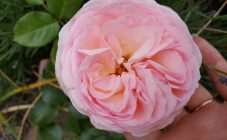Content:
This beautiful plant is worthy of being depicted on the canvases of the world's greatest artists. The delicate color of Versilia rose will not leave anyone indifferent. It enchants not so much with its color, so much with the velvet of the petals and the originality of the shape of the flower.
History
Versilia versilia rose was bred in the late 1990s. in France. The flower was liked by a large number of gardeners. The peach rose is not uncommon in city parks, gardens and dachas. But the beautiful view hides regular and scrupulous care. It depends on him whether the plant will please the eye with its unusual color.
Rose shocking Versilia will be an excellent garden decoration. The flowering time of a rose depends on meteorological factors. Under the most favorable conditions, it pleases the eye with its color from mid-June to the first autumn frosts.
Description of the variety
The shock rose of Versilia has an unusually beautiful peach blossom. Blooms profusely and unusually long. One flower contains up to 30 beautiful petals of a relatively large size. It retains its decorative properties for a long time. Plant height - up to 80 cm.
The buds are large, glass-shaped. The leaves are shiny, dark green. The bush is upright, strong.
The Versilia shocking plant is very resistant to rainy weather and practically does not deteriorate from drops of rainwater.
Features of agricultural technology
Prepare the soil before planting. The root system adapts perfectly if the plant is placed in warm soil. This means that you need to start planting in the warm season, when the threat of a return of spring frosts has already passed.
Landing
When planting, it is necessary to ensure that the depth of the hole is not less than 0.6 m. Half a bucket of rotted compost mixed with garden soil should be placed in the hole at half the depth. Then, after planting the rose, it must be watered abundantly with water.
The sequence of actions when planting a plant is as follows:
- A few hours before planting, dip the root in a bucket of lukewarm water. So the bush will be saturated with the moisture it needs.
- Then you need to very carefully remove the damaged parts and lower the bush into the planting hole.
- The hole is filled with a mixture of soil, humus and compacted.
- A small embankment should be formed around the hole, which will not allow water to overflow during irrigation. So it will be absorbed into the soil closer to the root.
- The rose must be watered with settled water at room temperature.
The place for planting roses should be chosen sunny. If it grows in shaded conditions, it will grow and bloom worse.
Reproduction
The rose propagates by dividing the bush, cuttings or layering. When dividing, immediately after the soil thaws, the rose is dug up and divided so that there are few roots and shoots left on each part of it.
When multiplying by layering in spring, the stems bend down and fit into grooves, pinned, and covered with earth. The shoot tip is placed outside. After several annular cuts, intensive root formation begins.During the summer, you need to constantly keep the soil moist.
Since the rose is thermophilic, for a better rooting process it is grafted onto a rosehip. It is more resistant to drought and frost. When budding, a rosehip seedling is used for 2 years.
Watering
Versilia hybrid tea rose does not need to be watered too often. The optimal frequency of watering is no more than once every 5-6 days. In this case, the amount of water should be significant. If it is hot in summer, the frequency of watering increases, but before that you need to make sure that the soil at a depth of about 8 cm is dry.
As autumn approaches, watering should be carried out less often. It is necessary to loosen the soil in a timely manner.
Top dressing
During the season, it is necessary to carry out up to 5 dressings. For this, either mineral compositions or universal mineral fertilizers are used.
It is preferable to use organic fertilizers. However, fresh manure is not used, it must be properly milled. Organic fertilizer should be applied diluted with water.
At the beginning of the summer season, the plant needs nitrogen and potassium fertilizers. When flowering begins, it is prohibited to apply any fertilizers.
Water the plant abundantly before and after fertilization. In no case should the fertilizer dosage be exceeded, since the plant may die.
Pruning
The bush must be cut in order to form a beautiful shape and prepare the plant for the winter. In the first case, the florist himself chooses the number of shoots in order to achieve the desired shape of the bush.
If you plan to trim the plant for the winter, then all the extra shoots that provoke excessive thickening of the bush are removed. By cutting them off, you can cover the plant for the winter.
Warming
The rose needs insulation, especially if the frosts exceed the twenty-degree mark. For this, spruce branches, grass and dry leaves are used. The whole plant is covered with a non-woven fabric.
In cold regions, you do not need to huddle bushes for the winter. This is due to the fact that the lignification process is somewhat weaker, and by the spring the plant will melt.
Advantages and disadvantages of the variety
Benefits of the Versilia rose variety:
- beautiful color and very pleasant aroma;
- significant duration of flowering;
- large size of flowers that have many velvet petals;
- flowers grow again, which ensures their preservation almost until the onset of winter;
- the plant is ideal for cutting flowers; it retains its properties for a long time in a bouquet;
- considerable height of the bush.
The disadvantages include the susceptibility of roses to diseases. With improper care, such diseases develop:
- Powdery mildew affecting leaves and shoots. Appears due to excess nitrogen fertilizers. With high humidity and insufficient moisture, plants are attacked especially quickly. Sick plants are treated with foundation.
- Rust manifests itself as a change in the color of leaves and stems. Moreover, the leaves may turn yellow and fall prematurely. Removed with Oxychom, Copper Oxychloride.
- Black spot affects the leaves. To prevent the appearance of this disease, it is necessary to destroy the affected leaves in the fall. Copper treatment helps to eliminate the disease.
- Bacterial cancer leads to root destruction. The disease appears on overly alkaline soils.
- Branch burn is a fungal disease that affects young branches by the end of summer. It is processed with special antifungal drugs.
Rosa Versilia (rose shock) is an excellent variety for cultivation in a summer cottage, near the house. Its unusually pleasant color scheme will not leave anyone indifferent. Correct agricultural technology allows you to extend the flowering time and protect it from pests and diseases.















